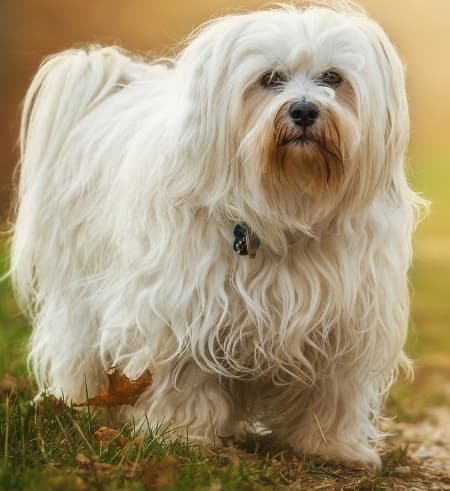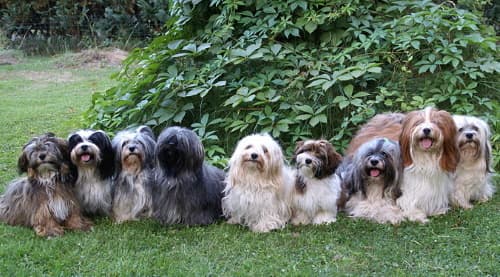Havanese Dog Breed
A Somewhat Rare Toy Dog Breed
The Havanese dog breed, recognized as the National dog of Cuba in 1993, is of Spanish origin and believed to derive from Bichón and possibly Tenerife breed lines.
Although this toy dog's numbers have dwindled dramatically in Cuba, the Havanese dog has now become very popular among the small dogs to own in the United States.

Their popularity is most likely due in part to a certain trendiness, their reputation for being easy to train, and because they do very well in therapy settings or when assistance is required.
History Of The Havanese
Historical information indicates that the Havanese dog arrived on Cuban shores during the period following the island's discovery by Christopher Columbus.
During the early part of the 20th century, this attractive toy dog breed was much favored by both the Cuban and European aristocracy, but subsequent wars in Europe as well as the Cuban revolution resulted in a considerable decline in their numbers.
The year 1959, in particular, had a significant impact on the Havanese dog breed numbers. This was the year when many Cubans left the country with their 'silk' dogs following Fidel Castro's takeover after the revolution. Fortunately the breed was saved from extinction and gradually rebuilt in the United States from a very small gene pool of just a couple of those families.
Today, from this new beginning, many dog lovers can enjoy this delightful dog.

Despite its small size, the Havanese, also known as the Havana Silk dog and/or Spanish Silk Poodle, gives the general impression of substance. He has a squarely built frame supported by strong legs, a bushy tail that he carries very jauntily and soft expressive eyes which may be black or dark brown.
Adorned with a profuse amount of curly or wavy hair that has a shaggy and tousled appearance, the Havanese is not easily mistaken for any other breed.
During the height of his popularity he was once a beloved pet in Queen Victoria's household and also of Charles Dickens.
Havanese Temperament and Behaviors

A great little companion and outgoing family dog. This toy dog breed is considered easy to obedience train and learns quickly if the owners are committed and consistent.
Both intelligent and lively, the Havanese it is an entertaining small dog with a delightful personality.
Being a very sociable dog by nature, he doesn't like being left alone for long periods. As such, he would be at his best with a work-at-home dog parent or families where someone is home most of the time.
Havanese dogs have protective instincts and being quite rugged and equally courageous, they are considered good watchdogs
Havanese Health
You can expect the Havanese dog breed to stick around for quite a while with an expected lifespan of up to 16 years if well-nurtured and given good care.
That being said, some of the more common dog health issues that may affect the Havanese are:
- early cataracts that can lead to blindness
- Hearing problems to include genetic deafness
- Patella luxation
- Liver problems
- Heart abnormalities.
In light of this, it is a good idea to include regular attention to eye cleaning and inspection as a regular part of grooming sessions, as well as provide support that is helpful to eye health. One of my dogs lost her sight from diabetes so I know how heart wrenching it is to have a dog go blind!
Also, because this breed has the type of ears that are more prone to ear infections and mites, they should be inspected and cleaned routinely - being careful not to go beyond the area you can see in the canal. While a certain amount of ear wax is normal, regular inspection will alert you to any excessive amount and/or bad odor which could be indicative of an ear infection or actually cause one!
Another condition that is hereditary and seems to be linked with the common problems is Chondrodysplasia, or CD for short. CD, as it relates the Havanese dog breed, has to do with assymmetric or bowed legs caused by the growth plates closing too soon or closing unevenly. For some reason when this happens, more of the other diseases mentioned seem to affect the breed.
Why this occurs is a good question to ask your vet, but it seems to me there may be a chemical imbalance that affects not only bone development, but perhaps development of other areas of the body as well.
The upshot of this is that when buying Havanese puppies, seek out a breeder that not only tests for CD, but can
also tell you about the health of the parents. In addition, conduct a careful inspection of the legs of the puppy
you are considering.
The Havanese Club of America plays an important preventative role in monitoring health related genetics of the breed.
Appearance
The height range for this breed is from 8 1/2 to 11 1/2 inches, with the ideal being between 9 and
10 1/2 inches.
Coat colors: Quite a lot of acceptable colors to choose from including cream, gold,
silver, blue, and black.
Coat And Care

This breed has a soft double coat, without the difference in texture between the two coats, as is
often seen in other breeds. The coat is silky in texture, quite long and abundant and has a very
appealing appearance.
Havanese dogs may be a good choice for allergy sufferers as they do not
do a lot of external shedding, but what that means is that the dead hair
stays more within the coat and does have to be removed.
Regular brushing with a high quality Pin Brush
is necessary to maintain the coat in good condition. Other helpful products for grooming a Havanese include
a butter comb and some
brushing spray to help with detangling when necessary.
Occasionally, a short coated dog may be produced in a litter, caused by a recessive gene, but this
is a deviation from the standard.
Despite its appearance, the Havanese tolerates the heat very well, partly due to the insulating quality of its coat.
Is the Havanese An Active Dog?
Although fairly active indoors, the Havanese dog does welcome and need quite a bit of regular outdoor exercise.
Plus the
fact that a daily walk maintains the mental and physical stimulation that every dog needs to be happy and
balanced.

What Are His Space Needs?
Energetic and generally not a yappy dog, this breed is quite adaptable and well-suited to either apartment living or a house.
Doesn't mind following you around all day providing he is taken out sufficiently.
The Havanese Dog Breed And Children?
From their early history the Havanese dog was employed as a playmate for
children and to this day are considered a wonderful family dog,
having an excellent reputation for getting along very well with
children.
They also generally get along well with other pets in the home.
That being said, early-socialization is the key as it is with all family dogs. And, because even the most social and tolerant dog can be unpredictable, the best
practice still remains to play it safe and have an adult supervise activites
between pets and children.
Seniors Or Sedentary Families?
The combination of intelligence, trainability and loyalty make Havanese dogs excellent and enjoyable companions for seniors or anyone living a more sedentary lifestyle.
They are very affectionate and their
use as therapy dogs has been well recognized, plus the exercise
needs are easily managed.

Recommended Reading

Small Dogs, Big Hearts
Covers everything you need to know about owning, breeding and raising a Toy dog breed. Great information for anyone planning to bring home a very small dog, or for that matter, any first-time pet owners.
Covers topics specific to little dogs including nutrition, health, socialization, training, exercise and much more. A handy reference and extensively illustrated.
Home › Miniature Breeds › Havanese
TOP

Resources: Creative Commons and Wikimedia
